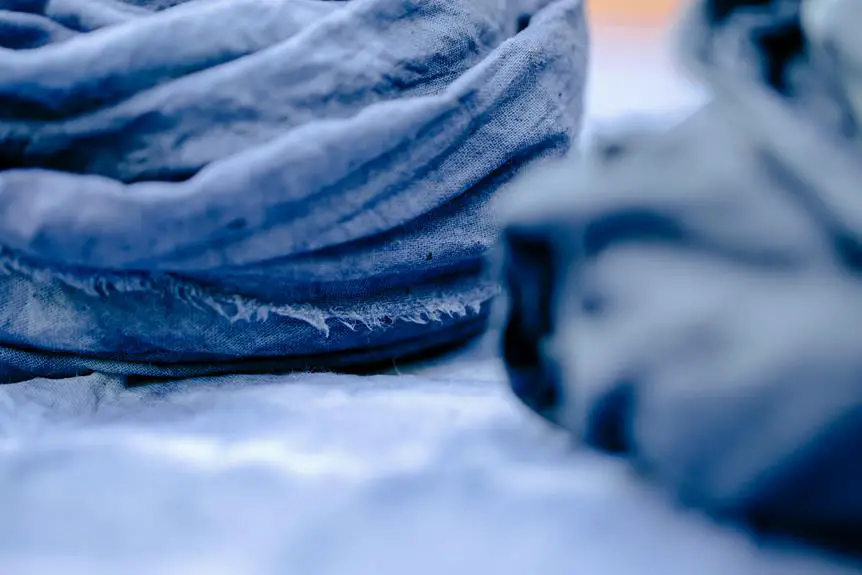If you're looking to add a personal touch to your acrylic fabric, dyeing it can be a straightforward yet rewarding process. You'll need to start by selecting the right dye and gathering some essential materials to ensure a successful outcome. After pre-washing your fabric, the dyeing process itself involves some careful steps that can lead to beautiful, vibrant results. But what happens if you don't set the dye correctly? Understanding the nuances of this process can make all the difference in achieving the lasting color you desire.
Table of Contents
Key Takeaways
- Choose dye specifically formulated for synthetic fibers to ensure vibrant and lasting colors on acrylic fabric.
- Pre-wash the fabric to remove any impurities and soak it in a fixative solution for better dye retention.
- Heat water to a simmer, mix in the dye, and fully submerge the fabric, stirring regularly for even color absorption.
- Rinse the dyed fabric in cold water until it runs clear, using mild detergent to help set the color.
Understanding Acrylic Fabric
Acrylic fabric, known for its lightweight and durable qualities, is a popular choice for various applications, from clothing to home décor. You'll find it in sweaters, blankets, and upholstery, often praised for its softness and warmth. One of the key features of acrylic is its ability to mimic the feel of wool at a fraction of the cost, making it an economical option.
When you're working with acrylic, it's essential to understand its distinct characteristics. Acrylic is a synthetic fiber, which means it's made from petroleum-based products. This gives it excellent resilience against wrinkles and fading, making it suitable for both indoor and outdoor use. However, it also means acrylic can be more challenging to dye than natural fibers.
You might notice that acrylic's structure can repel certain dyes, which is why knowing its properties is vital before you start your dyeing project. Additionally, acrylic fabric is typically resistant to mildew and mold, adding to its versatility. Understanding these aspects will help you make informed decisions when preparing to dye acrylic fabric, ensuring your creative vision comes to life effectively.
Choosing the Right Dye
When dyeing acrylic fabric, it's crucial to choose a dye specifically formulated for synthetic fibers to achieve vibrant and lasting results. Look for dyes labeled as 'acrylic dye' or 'synthetic dye.' These products contain chemicals that effectively bond with the fibers, ensuring the color adheres well and remains bright after washing.
Before purchasing, consider the color you want. Dyes come in various shades, so pick one that matches your vision. If you're unsure, check online reviews or color charts to see how the dye looks on acrylic fabric.
You also need to pay attention to the dye type. Some dyes require heat to set the color, while others might work at room temperature. Be sure to read the instructions carefully to understand the process.
Lastly, consider the brand. Renowned brands often provide better results and color retention. If possible, buy from a reputable craft store or online retailer to ensure quality.
Preparing Your Materials
Gather all the necessary materials, including the dye, a large container, gloves, and a stirring tool, to ensure you're ready for the dyeing process. Choose a dye specifically made for acrylic fabric, as regular fabric dyes won't work effectively. You'll also need hot water, as heat helps the dye bond with the fibers.
Next, find a spacious area to work in; dyeing can get messy. Cover surfaces with plastic or newspaper to protect them from spills. Make sure you have a reliable source of heat, whether it's a stovetop or a microwave, to prepare your dye bath.
Don't forget to wear old clothes or an apron, as dye can stain fabrics. If you're using powdered dye, have a mask on hand to avoid inhaling any particles. Check your fabric for any tags or labels; removing them will make the dyeing process smoother.
Lastly, consider having a timer or clock nearby; keeping track of time is crucial during dyeing. With everything in place, you're now set to dive into the next step of transforming your acrylic fabric.
The Dyeing Process
Now that you've prepared your materials, it's time to focus on the dyeing process.
You'll start by getting your fabric ready, ensuring it's clean and damp.
Then, you'll apply the dye to achieve the vibrant color you want.
Preparing the Fabric
Preparing your acrylic fabric is essential for achieving vibrant and even color during the dyeing process. Start by washing the fabric to remove any dirt, oils, or finishes that could interfere with dye absorption. Use a mild detergent and cold water, then rinse thoroughly. This step ensures the dye adheres properly.
Next, check your fabric for any stains or imperfections. If you find any, treat them before proceeding. After washing, you'll want to soak the fabric in a solution of warm water and a fixative, like vinegar or salt, which can help enhance dye retention. Follow the recommended ratios for the fixative based on your fabric's weight.
Once soaked, gently wring out excess water but don't let it dry completely. It should be damp when you start dyeing. If you're working with multiple pieces or colors, consider grouping them by how they'll be dyed to keep things organized.
Applying the Dye
With your fabric damp and ready, it's time to apply the dye for a stunning transformation. First, mix your dye according to the instructions on the package, ensuring you have the right concentration. Use a plastic container to avoid staining surfaces.
Now, put on your gloves to protect your hands. Dip your fabric into the dye bath, ensuring it's fully submerged. If you're aiming for an even color, stir the fabric gently for a few minutes. For a more textured or variegated look, you can remove the fabric periodically and let some areas soak longer.
Keep an eye on the time; most dyes need anywhere from 20 to 60 minutes to set. Check the color periodically by lifting the fabric out of the dye bath.
Once you're satisfied with the shade, carefully remove the fabric and rinse it under cold water until the water runs clear. This step helps remove excess dye and enhances colorfastness.
Setting the Dye
To ensure your dye adheres properly to the acrylic fabric, you'll need to set it using heat or a fixative. This step is crucial for achieving vibrant, long-lasting colors.
Here's how you can effectively set the dye:
- Choose Your Method: Decide whether you'll use heat or a chemical fixative.
- Heat Setting: Use an iron on medium heat. Place a cloth between the iron and the fabric to avoid direct contact. Press firmly for about 5-10 seconds in each area.
- Chemical Fixative: If using a fixative, follow the product instructions closely. Typically, you'll soak the fabric in a solution for a specific time before rinsing.
- Rinse: After setting, rinse the fabric in cold water to remove any excess dye and fixative.
Caring for Dyed Fabric
Once you've dyed your acrylic fabric, it's crucial to know how to care for it properly.
You'll want to follow specific washing instructions to maintain the vibrant colors and avoid fading.
Additionally, keeping your fabric stored correctly will help preserve its quality for years to come.
Washing Instructions
After dyeing your acrylic fabric, it's essential to follow proper washing instructions to maintain the vibrant colors and overall quality. Here are some key tips to keep your dyed fabric looking its best:
- Wash with cold water: Use cold water to prevent colors from bleeding or fading.
- Use a gentle detergent: Opt for a mild detergent specifically designed for delicate fabrics.
- Avoid bleach: Never use bleach, as it can damage the fabric and ruin the dye.
- Hand wash or use a gentle cycle: If machine washing, select a gentle cycle to minimize agitation.
Storage Tips
Proper storage of your dyed acrylic fabric helps preserve its vibrant colors and quality for years to come. To ensure longevity, start by folding the fabric neatly rather than hanging it. Hanging can cause stretching or distortion, especially if the fabric is heavy. Instead, stack the fabric in a cool, dry place away from direct sunlight, which can fade colors over time.
When storing, use breathable cotton or muslin bags instead of plastic, as plastic can trap moisture and lead to mold. If you must use plastic bins, consider adding silica gel packets to absorb any humidity. Make sure the fabric is completely dry before storage to prevent mildew.
Avoid storing your dyed acrylic fabric near harsh chemicals or cleaning supplies, as these can cause discoloration or damage. If you're storing it for an extended period, check on it periodically to ensure it remains in good condition.
Lastly, be mindful of temperature fluctuations; storing in a stable environment is key to maintaining your fabric's beauty. By following these tips, you'll keep your dyed acrylic fabric looking fresh and vibrant for many projects to come.
Frequently Asked Questions
Can I Mix Different Dye Colors for a Unique Shade?
Absolutely, you can mix different dye colors to create a unique shade! Experiment by combining small amounts of each dye until you achieve the desired color. Just remember, mixing colors can yield unexpected results, so have fun!
How Does Dyeing Affect the Fabric's Texture?
Dyeing can change the fabric's texture, often making it feel softer or slightly stiffer, depending on the dye and method used. You'll want to test a small swatch first to see how it reacts.
Is It Safe to Dye Acrylic in a Washing Machine?
It isn't safe to dye acrylic in a washing machine. The high heat and agitation can damage the fabric, leading to uneven color and potential shrinkage. Stick to safer dyeing methods for best results.
What Happens if I Use the Wrong Type of Dye?
If you use the wrong type of dye, you'll likely end up with uneven color, fading, or no color at all. It could damage your fabric, affecting both its look and texture.
Can I Dye Acrylic Blends With Other Fibers?
Yes, you can dye acrylic blends with other fibers, but the results may vary. Different fibers absorb dye differently, so you might not achieve the desired color intensity or consistency across the entire fabric.
- How Does Ring Spun Cotton Affect Garment Fit and Shape Retention? - August 13, 2024
- What Are the Challenges in Producing Ring Spun Cotton? - August 13, 2024
- Is Ring Spun Cotton Suitable for Plus-Size Clothing? - August 13, 2024





